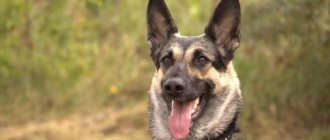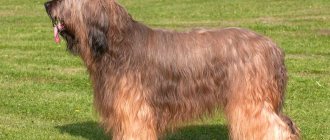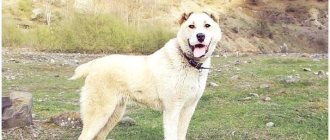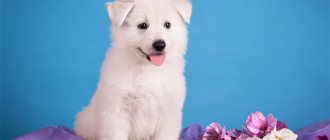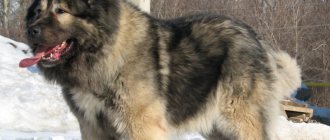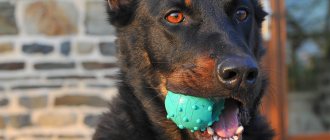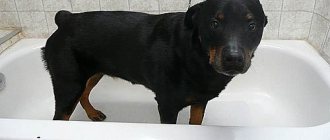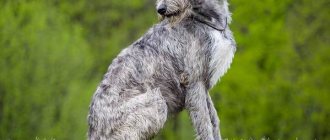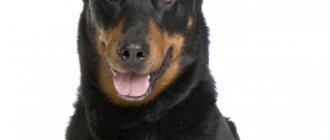Maintenance and care
The breed is distinguished by its unpretentiousness, ability to quickly adapt to various conditions, and endurance. Caring for English Shepherds does not require much effort.
Nutrition
The diet for English Shepherds is selected taking into account the age of the animal. Dry food should belong to the premium segment for active breeds. Natural food must meet the requirements of balance. The diet should include meat, offal and meat trimmings of beef, veal, lamb, fish, cottage cheese.
In addition to meat products, dogs need multivitamins, beneficial microelements, Omega 3, 6 and 9.
Puppies need to be fed four times a day, in small portions. They grow quickly and gain weight. But the diet should not be high in calories, so as not to harm the functioning of the intestines. Due to the tendency of puppies to overeat, it is necessary to carefully monitor the amount of food eaten. After eating, the bowl must be removed to teach the animal discipline. Water must be available at all times.
Health
The English Shepherd breed, obtained through natural selection, has almost no diseases that arise due to hereditary predisposition. In general, the animals are in good health. Among the representatives of the breed there are many long-livers. The average life expectancy is 12 – 15 years.
Vaccinations
Dogs of the English Shepherd breed are required to carry out standard veterinary preventive measures. These include vaccinations, as well as tick and flea treatment and deworming.
The vaccination schedule can be drawn up by a veterinarian. It is also acceptable to adhere to the general vaccination schedule. One of the most common involves the following vaccines:
- 6 weeks – against parvovirus and plague;
- 9 weeks – against parvovirus, plague, adenovirus, parainfluenza and hepatitis;
- 3 months – revaccination;
- 6 months – against rabies;
- 12 months – against leptospirosis and rabies;
- 3 years and then annually - revaccination.
Diseases
Accurate statistics regarding diseases specific to English Shepherds are not available due to the small number of representatives of the breed. Pet owners and breeders note the following problems they have encountered:
- Hip dysplasia;
- Sensitivity to anesthetic agents;
- Allergic reactions;
- Collie eye abnormality;
- Cataract.
Walk
Animals must be walked daily. Each walk should last more than an hour and include vigorous physical activity. For her, it is worth choosing an open, uncrowded area so that the dog can run a lot. In addition, animals are happy to take part in training on equipped areas. Without long walks and physical activity, dogs can become lethargic.
- The English Shepherd's luscious coat requires grooming, although tangles and tangles are rare. In order for the animal to look well-groomed and for its fur to remain soft, it is necessary to comb it every two days. And once a week it is recommended to use a brush with stiff bristles.
- The dog is losing a lot of hair. The most intense seasonal shedding occurs in spring and autumn, so keeping an English Shepherd in an apartment causes a lot of inconvenience.
- You shouldn't bathe your dog too often. This can be done as the wool gets dirty. In summer, animals enjoy swimming in ponds.
Beauceron health
Beaucerons are distinguished by good health, even hereditary pathologies are very rare among them. But acquired diseases occur with improper care. Thus, with age, pathologies of the musculoskeletal system can develop, so it is recommended to protect puppies under 1 year from increased physical activity. In the future, if there are signs of any abnormalities (changes in gait, lameness), you should immediately contact a veterinarian.
Gastric volvulus is a rare but dangerous pathology in Beaucerons. It involves twisting the organ and can lead to the death of the pet within 3–4 hours. To avoid this, after feeding the dog is not allowed to move actively for 1 hour. It is better to feed her after the first morning and last evening walk.
Vaccination of a dog is mandatory according to the schedule established by the veterinarian. Usually vaccinations have already begun in the nursery; the owner must continue to perform them. Antiparasitic treatments are carried out once every 3 months, and 2 weeks before each vaccination, anthelmintic drugs are additionally given.
Beaucerons live about 10–12 years.
Education and training
Raising a little Beauceron begins from the first days of being at home. A feature of the breed is its late maturation - males become adults only at 2.5-3 years, females a little earlier. In this regard, the owner will have to keep the process of raising the Beauceron under control for quite a long time.
Raising a puppy should be done by the owner, without involving other family members, so as not to mislead the puppy and earn authority. The little Beauceron must be taught the basic rules: accustom him to the place, diet and walking schedule, establish a ban on begging for goodies and damaging things.
They begin training at 5 months, acting patiently and without aggression. Training should take the form of active play - Beaucerons cannot stand monotony.
Classes are held in a remote place where nothing will distract from the execution of commands. You need to start training either before meals or 4-5 hours after eating. Since the reward is done with treats, a well-fed dog will not be interested in it.
Here is a video of a Frenchman showing a “bunny” for a tasty treat.
https://www.youtube.com/watch?v=7ELF8CmD9D8
Rules for keeping pets
All pets of herding breeds are kept in enclosures or spacious pavilions; it is not advisable to keep them on a chain, and their large size will not allow them to live with you in an apartment. Dogs love long walks, fresh air, exercise, and are not averse to hunting and observing their surroundings. Thick and dense wool will not allow the pet to freeze in cold weather and cold; for insulation, it is enough to add hay to the kennel.
When raising a puppy, you should be strict and reward him with goodies for positive achievements in training. Try to walk the puppy in public places to accustom it to society; in adulthood, it is necessary to have a muzzle and a strong leash. Remember, full maturation and maturation lasts up to two years, during this period the pet may behave atypically, be patient and do not stop training.
History of the Beauceron breed
The Beauceron is a purebred French shepherd that has never crossed with other breeds throughout its existence. The exact origin of this dog today cannot be established, but many experts are inclined to believe that its ancestor is the French turf dog. Others argue that the Beauceron breed originated from wild wolves and, in the process of evolution, acquired modern characteristic features.
Beauceron French Shepherds have never been crossed with other breeds, which is why they are a type of purebred dog breed.
However, the first mention of the dog dates back to 1578. Later, in the 18th-19th centuries, when French agriculture was experiencing the heyday of sheep breeding, the Beauceron gained popularity as an excellent guard dog.
The Beauceron is a guard breed capable of guarding flocks of several hundred sheep.
In 1863, the first dog show was organized in Paris. There, a previously unknown dog of rural origin, the Beauceron, was presented. Despite its proud posture and stern, direct gaze, this breed did not receive the general attention of exhibition visitors, which is not surprising: miniature dogs or hunting greyhounds aroused much more interest at that time. However, the “Boss shepherds” were still officially recognized in 1863. Their other name, which is still preserved in some places, is “red stockings” (French bas rouge), obtained due to the reddish-red color of the bottom of the paws, which was better remembered then.
In 1896, the already known Jean-Pierre Menin, farmer and owner of herding dogs Emmanuel Boulet and the French Minister of Agriculture Ernest Menod gathered in the village of Villette to set standards for the Bosque shepherd breed. Then the main division of one breed into two was made: long-haired herding dogs began to be called Briard shepherd dogs (berger de Brie - Brie shepherd, where Brie is a region in France), and the name Beauceron was finally assigned to the smooth-haired ones.
The French Briard Shepherd is a long-haired analogue of the Beauceron breed.
Later, the French Shepherd Dog Club was formed in France, and in 1911 Jean-Pierre Menin organized the French Club of Friends of the Beauceron (Club les Amis du Beauceron), which was engaged in maintaining the characteristics of the breed and popularizing it among dog lovers. However, over time, sheep farming ceased to be a popular branch of agriculture, and the main area in which the Beaucerons were involved began to disappear. Concerned about preserving the existence of the breed, the Friends of the Beauceron Club began to introduce herding shepherd dogs as guard dogs to protect homes and people.
The Beauceron is a breed that copes well with the duties of a watchman and companion, capable of protecting the home and family members from attacks by intruders.
It was only in the early 2000s that Beaucerons first appeared outside of France. In 2003, the American Beauceron Club appeared in the United States. However, this breed, unfortunately, never gained much popularity overseas.
Best articles: Description of the periods and eras of the Cenozoic
Learning ability
The Beauceron's ability to learn deserves the highest rating (on a five-point scale, this quality is rated five out of five). She takes great pleasure in mastering and following her owner's commands. For this dog, training is not just a job, for it it is a vital necessity.
French Shepherd Beauceron: description, photo, character, care
Description and features
The Beauceron breed is ideal for herding work. The dog is responsible, attentive and energetic. He loves sheep, pigs and even chickens
He likes to look after them, and it doesn’t matter if the owner is nearby
In urban environments, a dog is also very useful. She gets along well with people and even their small animals. Gets along well with any living creatures. Suitable not only for small but also for large families.
Some owners of such an animal say that they cannot find a better guard. The Beauceron is a good bodyguard and watchman. He understands that the territory in which he lives is the property of the owners, which other people should not enter with impunity.
The uniqueness of the dog is not only in its independent, natural formation, but also in the absence of the need for serious training. Nature has endowed the dog with good working qualities, so its owner does not need to teach it to guard or obey.
A well-mannered Beauceron will never attack a stranger if he understands and feels the owner’s affection for him. He “reads” the emotions of a loved one always, in any situation. If they are negative, he approaches and prepares for an attack, but if, on the contrary, they are positive, he will entrust control over the situation to the owner.
By the way, this dog is also good because it tends to trust. She will not make serious decisions on her own, like, for example, the Central Asian Shepherd, but will prefer to listen to the wishes of the owner.
We emphasized above that the French Shepherd is a good option for large families. She likes to be the center of attention of a large company, play and be useful. I don't tolerate loneliness well.
Long walks with family members make the dog happy; at these moments he is happy. But in order for the animal to gain experience, it is recommended to go for walks with it more often and periodically change locations.
In France, the dog began to be used to help farmers only in the 18th century. Even then, he established himself as a fearless and responsible manager whom you can safely rely on. The Beauceron could move a flock of sheep 50 km in a day.
His lack of fear made him a useful defender. Wolves did not pose a threat to the farmer and his animals, since such a dog could easily fight them off. Of course, she had no chance against a pack of forest predators. But group raids by wolves were rare for those times.
By the end of the 19th century, the French Shepherd breed standard was determined. A little later, a club of its lovers was created in France. It was after this that Beauceron breeders began to appear in the country and popularize them.
Unfortunately, these dogs never gained widespread popularity. This is probably due to the decline in farming. The need to keep a four-legged shepherd-hunter at home disappeared.
Interesting fact! During World War II, the Beauceron was used as a communications dog. She could move silently across different terrain, bringing letters to the addressee. The animal’s excellent sense of smell also allowed it to easily and quickly find enemy saboteurs.
The breed was popularized recently, or rather at the beginning of the 21st century. Today its representatives can be found in the Netherlands, Belgium, England, Germany and other countries. In the United States of America, the Beauceron Club was organized in 2003.
Pride of the CIS countries
Among the French, English and Swiss breeds, Russian and Asian representatives are not lost. Dogs are characterized by a formidable and massive exterior, but a kind and flexible character, these include:
- Alabai.
- South Russian Shepherd.
- Caucasian Shepherd Dog.
South Russian Shepherd
Another formidable good fellow. As a result of crossing greyhounds with shepherd dogs, a fantastic dog with long thick hair and excellent watchdog qualities was obtained. Very smart, discreet, positive and intelligent dogs are often used as watchmen and perform guard duty, and also fulfill their direct duty - guarding herds of sheep, merging with the general mass, because outwardly they resemble a harmless lamb.
Caucasian Shepherd Dog
The most common breed in Russia. It is often kept to protect the state border, serious objects and private lands. The Caucasian is a strong, muscular, brave, fearless, intelligent and determined watchman. With proper training and skillful upbringing, he grows up obedient and restrained, listens to his owner and does not attack without reason, but you should not contact him without the presence of the owner.
Alabai
A seemingly formidable, strong, impressively sized dog can become an affectionate and loving friend, an excellent watchman and shepherd. The Central Asian Shepherd Dog has undergone strict natural selection, surviving in harsh conditions and fighting off attacks from predators - all this has left a mark on the character of the animals. They have become more resilient, stronger, smarter and more reasonable; Asians will not stupidly carry out commands if they do not see its need.
They are very popular in security organizations, on farms, border areas and private sectors.
Brief characteristics of the Beauceron dog breed
- Other possible dog names: French Shepherd, French Smooth Shepherd, Berger de Beauce, French Shorthaired Shepherd, Beauce Shepherd, Berger de Beauce, Bas Rouge (Red Stocking).
- The height of an adult dog is 63-71 cm, a male has an average height at the withers of 66-71 cm, a female is slightly lower - 63-66 cm.
- Weight: 30-45 kg.
- Distinctive color: black and tan, known as "bas rouge", or "red stockings", which characterizes the color of the dog's paws. A tri-color harlequin is also allowed: grey, black and tan.
- Coat length: The coat is short, which is a characteristic feature of the Beauceron in contrast to the Briard, also a herding breed of French origin.
- Life expectancy: on average 10-14 years.
- Advantages of the breed: calm character, obedience, vigilance, courage, endurance, patience, goodwill and intelligence, moves easily, loyalty and devotion to people.
- Difficulties of the breed: Beaucerons do not tolerate loneliness well, they can become too freedom-loving and uncontrollable if they do not receive proper training.
- How much does a Beauceron cost: from 800 to 2200 US dollars.
Puppies
For the first 5–6 weeks, French Shepherd puppies are in the care of their mother. But if there is not enough milk, you should purchase special milk formulas from a veterinary pharmacy and use them according to the instructions. At about 1.5 months, Beaucerons begin to be additionally fed with twisted meat and vegetable purees.
At 2–2.5 months, the puppy usually moves to new owners. They continue to give him the same products that the breeder used - Beaucerons tolerate sudden changes in diet very poorly. The menu must include fermented milk products, since the dog’s skeleton is actively developing.
At 3 months, the puppy is given meat porridge. The meat is no longer rolled, but cut into small pieces. From 4 months, the French Shepherd is allowed to give offal (lungs, heart, liver) and sea fish. After changing teeth, the amount of dairy products is reduced, replacing them with meat. At six months the diet is as close as possible to that of an adult, but more food is given as the dog is still growing.
Frequency of feeding of a French Shepherd depending on age:
- 1–3 months – 5–6 times a day;
- 3–6 months – 4 times a day;
- 6–9 months – 3 times a day.
From ten months, the Beauceron is fed like an adult dog twice a day.
You can monitor the development of your French Shepherd using a table that shows the dynamics of height and weight by month.
| Age (month) | Height (cm) | Weight, kg) |
| 1 | 20–22 | 3.8 |
| 2 | 34–38 | 8.7 |
| 3 | 40–45 | 14 |
| 4 | 46–50 | 18.6 |
| 5 | 50–56 | 22 |
| 6 | 51–61 | 24.5 |
| 7 | 52–62 | 26.5 |
| 8 | 53–63 | 27.5 |
| 9 | 55–64 | 28.5 |
| 10 | 57–66 | 29 |
| 11 | 58–67 | 29.5 |
| 12 | 59–68 | 30 |
Keeping a French Shepherd
The Beauceron is suitable for keeping both in a country house and in an apartment. But each case has its own nuances.
In a country house
Keeping it in a country house is the most preferable option for the Beauceron . Since ancient times, this breed helped herd herds all day long, so it is characterized by high physical activity and tirelessness. If it is not possible to allow the dog to move freely throughout the yard, an enclosure is provided for it. Considering the cold winters and dank off-season, it is better if it is an insulated enclosure with wooden flooring, closed on three sides from the wind. It must also be equipped with a shelter (booth).
Keeping a pet in an enclosure does not relieve the owner from walking the pet daily. This should be done at least twice a day for 1.5 hours. This dog needs to move a lot, so during walks you must include it in various outdoor games.
The Beauceron needs a lot of exercise every day
In the apartment
The Beauceron may well live in an apartment, provided that the owner compensates the pet for the lack of physical activity on a daily basis. If there is no place within the city where you can give your dog the opportunity to frolic, then agility training with him would be a good solution.
Agility is a great opportunity for the Beauceron to stay in great shape
Agility is a sport for dogs that involves overcoming various obstacles (slides, barriers, walls, swings, etc.).
On weekends, it is still advisable to travel with your pet out of town, where he can run around to his heart’s content. Limiting physical activity is a direct path to the development of diseases in a dog and shortening its life. Therefore, the requirements for walking your pet should not be neglected.
Beauceron - price and how to buy correctly
When choosing a puppy, you should first pay attention to its parents. They must fully comply with the standards
Breeders are required to provide a pedigree up to 5 generations. Since the breed is not in demand, puppies will have to be booked in advance. The wait can last quite a long time. This time can be whiled away by getting to know the breeder and the parents of the chosen individual.
It is almost impossible to buy a puppy secondhand in Russia. Any offer from unofficial sources will be an absolute scam. Only a kennel can guarantee the purity of a dog. A puppy is purchased at approximately 7 weeks of age. By this time, the baby will have passed all possible tests. Based on the results, you can understand what kind of character the pet will have and how developed its working qualities will be.
If checks have not been carried out on a specific individual, you should focus on external signs and temperament. The puppy should be playful, cheerful, and curious. He should have a shiny coat, without bald spots. There should be no unpleasant odor from the ears, and the eyes should be clean. The puppy should not show aggressiveness, there should be no barking for no reason, and apathy towards everything that happens.
Best articles: Characteristics, role and formation of cellular lysosomes
The rarity of the breed is directly related to the cost of the puppies. Buying from unofficial breeders will cost 10-20 thousand rubles. However, with this method of purchase, the owner runs the risk of acquiring a mestizo that looks like a Beauceron. The cheapest price is for a pet-class pet. Its cost will be about 30 thousand rubles. An individual for breeding is estimated at 40 thousand. A show-class puppy will cost 50 thousand rubles and more.
The purpose and character of the Beauceron
By its intended purpose, the Beauceron is a herding dog, but in urban conditions it can become an excellent family and guard dog, a good hardy travel companion or long walks in nature. The Beauceron has excellent instincts, so it can serve in the police, customs and army.
Beaucerons are unusually devoted to their owner. They are valued for their calm disposition, courage and intelligence. Beaucerons get along well in the house with older children and are protective of younger ones. They are able to protect the owner in any conditions. They treat strangers with great distrust, which is why Beaucerons are excellent guards and guard dogs.
How to choose a puppy?
Every person who wants to become the owner of a Beauceron must understand that in Russia such a dog is considered a rarity. Therefore, simply buying a breed will not work. All offers from the poultry market will be a hoax. A purebred animal can only be purchased from a trusted nursery that breeds Beaucerons. Since there are very few such nurseries, you often have to wait a long time for a puppy.
The waiting time can be spent getting to know the breeders, the parents of the future puppy, assessing their character and mental abilities, and studying the pedigree. It is customary to take a puppy home when it is at least 2.5 months old. In nurseries, by this time, the animal will be able to undergo specialized testing of this breed, thanks to which you can approximately understand what kind of temperament the dog will have and what working qualities are inherent in it.
When purchasing a Beauceron, you should definitely check the test result of the selected puppy. Some nurseries neglect testing, so you can use the following rules when choosing.
You should pay attention to the most lively and playful representatives. The puppy should be cheerful, active and curious. At 7 weeks, the puppy should be large in size and have a shiny and glossy coat. The puppy's eyes and ears must be clean, and an unpleasant odor is not allowed. Healthy representatives have thick paws with strong bones. There will definitely be two extra toes on the hind legs. The iris of the eyes should be dark
The darker the better. "Harlequins" can be odd-eyed. The tan is light, with a yellow tint. With age, it may become dark, but it is better to choose puppies whose color initially matches the color of the adult representative.
Experienced breeders advise resorting to recommendations that will help you choose a suitable puppy
First of all, you should pay attention to the manufacturer
- You need to ask the breeder for the results of tests for THD, the results of behavior testing and exhibition ratings.
- The pedigree must be carefully studied. Ideally, the puppy's distant relatives should also undergo testing and training. If the names of animals are constantly repeated in the pedigree, you need to clarify what exactly the breeder wanted to show. Usually such a gesture is made by dog handlers who reinforce the character and or exterior of the animal.
- The presence of marriage should also be studied. Litters with parents who are close relatives deserve special attention.
- If this is not the first litter of the parents of the chosen puppy, you should clarify the disadvantages and advantages of previous litters.
- You need to communicate with the puppy’s parents in person. It is best to conduct the acquaintance on neutral territory in order to assess the behavior of the animal. The Beauceron should not behave aggressively or be too affectionate towards strangers.
- If adults have certificates from training courses, you should ask the breeder to demonstrate some skills. Not all documents can be trusted.
- Hyperactivity or excessive inhibition is also not a good sign. If manufacturers have such a character, you should think about it. The puppy can inherit the traits of its parents in the first option, but it is not entirely suitable for a family with small children and elderly people.
- If it is not possible to communicate live with the producers, you can use the video archive of the Russian Beauceron.
History of origin of the breed
Beauceron dogs were developed in the 1500s in France. The Beauceron is descended from the "plain dogs" that guarded herds near Paris.
At the moment, there are two versions of the origin of this breed. According to the first version, the Beauceron is a descendant of the turf dog that once lived in France. According to the second version, the Beauceron is a descendant of ordinary wild wolves, the similarity with which dogs of this breed have is significant. The French Shorthair Shepherd appeared naturally, changes in the breed occurred in accordance with its evolution.
The first mention of the breed dates back to 1578, but the Beauceron was officially recognized only in 1863, when the standard was adopted.
At the end of the 19th century, short-haired “plain dogs” received the name Beaucerons, and long-haired ones began to be called Briards. Like its closest relative, the Briard, the Beauceron originates from the French department of Brie.
Breeders sought to consolidate the various qualities of the Beauceron breed: ability to serve, exhibition exterior, fighting character.
The breed was established in its final form by the end of the 19th century. E. Boulet, known for introducing griffons into the international canine classification, initiated the founding of the Beauceron breeders club in 1896. In 1911, a club of Beauceron lovers appeared.
The breed got its name “BasRouge” (red socks) because of the characteristic tan marks on its legs.
The Beauceron is very popular in France. In other countries, with the exception of Belgium, the Beauceron breed is practically unknown.
The Beauceron is a large sheepdog that was used by farmers to protect cattle, sheep and the entire family. Later, these dogs began to be used as messengers for the French army, during World Wars I and II, where they were highly valued for their ability to detect mines, look for tracks and find the right directions. During the formation of the breed, the Beauceron was used both for hunting wild boar and as a shepherd and watchman. Nowadays it is also used as a police dog, a guide dog and a wonderful companion.
Distinctive features of the breed
In the 19th century, the Beauceron belonged exclusively to a number of working dogs that could keep herds of sheep under control, and no one considered the pets of this breed attractive.
Over time, this trend became irrelevant and puppies of this breed were distributed all over the world. An adult male dog reaches a length of about 70 centimeters, the dog's weight can reach about 45 kilograms. This pet lives for about 11 years if you care for it properly.
If we describe the characteristics of the breed in more detail, we can characterize Beaucerons according to the following criteria:
- almost always black coat with gray or red spots;
- The length of the fur is no more than 4 centimeters, it is coarse and thick;
- in winter, your pet’s coat is slightly denser than in summer;
- the Beauceron's neck is quite muscular, the chest is wide, the shoulders are well developed;
- dogs have dewclaws on their toes, but unlike other breeds, this does not become a reason for their disqualification at exhibitions;
- the dog is smart and resilient, but is a little wary of strangers;
- pets of this breed are devoted to their family and love children very much;
- Beaucerons are aggressive towards other dogs and other pets;
- Dogs regularly need training, as well as great mental stress.
Best articles: 6 main groups of animals, their brief characteristics and photos
Young Beauceron age 7 months
Dogs of this breed are very loyal to their owners. The Beauceron in the photo looks very majestic and will also behave properly at home.
Character
The Beauceron is sociable. Likes to work with people, but he has a very independent character. A true Frenchman will not bow down to you. This is a one owner dog. She will be loyal and respectful to you, but will demand the same respect in return. This dog has a balanced and calm character; you won’t expect too violent manifestations of feelings from it - it won’t run towards you squealing and tumbling. But be careful, if this dog gets angry, it can become ferocious. The dog is smart and quick-witted, and will undoubtedly become an excellent assistant for you, provided that you do not neglect training with it.
Description of the Beauceron breed
The herding dog is lucky in that it has changed little over time. At first there were few Beaucerons, and people did not try to interfere with the natural processes of the formation of the breed. Later the club's work maintained standards by harshly removing unsuitable dogs from breeding. In total, there are about 7,000 Beaucerons in France and abroad.
Barefoot dogs are large dogs, but do not look overweight. The size of a male at the withers reaches 65-70 cm, and that of females 61-68 cm. Taller or smaller dogs are rejected. The weight of the shepherd is 40-50 kg. The muscular body is covered with coarse hair. The length of the body is slightly greater than the height at the withers. The head is proportional to the body. The ears are usually cropped.
Appearance of a Beauceron dog
Coat and color
The shepherd's coat is smooth and lies tightly to the body. Its length is 3-4 cm. The hair is longer on the hind legs and tail. The undercoat is soft gray in color, but is not visible through the dense guard hairs. Shepherd dogs are black with red tan and red stockings. You can identify the breed by the scorch marks, which are located:
- above the eyes;
- on the sides of the muzzle;
- on the chest;
- under the neck;
- under the tail;
- the lower third of the paws, slightly higher on the inside.
Another acceptable color is harlequin. It is a combination of blue, gray, black. The tan marks are distributed over the body in the same way as in the previous color.
French Shepherd Beauceron - harlequin color
Head
The Beauceron's head is prominent with a pronounced occipital protuberance and a defined midline. The skull and muzzle are the same length. If you look from the side, they are in parallel planes. The muzzle is elongated, but not pointed, of proportional width (not narrow). The nose is black and regular in shape, not forked. The ears are erect with a slight overhang and do not fit tightly to the skull. Docked - located vertically. The ear size is half the length of the head. The Beauceron dog breed has dark lips and a scissor bite. Black dogs should have dark brown eyes, while harlequins should have light eyes.
Beauceron with cropped ears
Body
The Beauceron dog has a straight, muscular back with a short loin and a sloping croup. The massive neck goes into well-defined withers. The powerful, wide chest has good length, exceeding the height at the withers. The shepherd's tail is straight and low to the hocks. When excited, the dog raises it to the level of its back.
Paws
The front legs are straight, the shoulders are developed and strong. The hind limbs are developed, the thighs are muscular. The hock joints are one quarter of the height of the withers. A special feature of Beaucerons is their dewclaws on the hind legs, which are not usually removed. Paw pads are dark. The fingers are tightly packed, the color of the claws should be black.
The dog moves at a wide trot. Movements should be light and sweeping.
Characteristic
The Beauceron is considered a guard and herding dog, although it should be understood. that the guard and the shepherd are different dogs. But the Beauceron perfectly mastered these two dog “professions” at once.
These dogs have one very interesting one. A unique feature is that on their hind legs they have a forked, so-called dewclaw. As a rule, in other breeds they are stopped, but in these dogs and in a number of other mastiffs they are left, especially if it is forked. It is this feature that is considered a sign of breed at exhibitions. This indicates the antiquity of the breed.
In the mid-18th century in Paris, a certain monk Rosier published a book on how to use dogs in rural life. The book was extremely popular at the time. This monk argued that it was precisely these short-haired dogs with cloven toes on their hind legs that must be used as guard dogs to protect the herd.
Beauceron - description and characteristics of the breed
FCI breed standard: No. 44
This standard shows that these dogs are quite strong and well built. Ideally adapted to completely different habitats.
Beaucerons are almost universal dogs. They were widely used by the French army and police. They served as signalmen. bloodhounds, detectives. They guarded warehouses and positions. But still, the first “profession” of these dogs is a shepherd.
It is very interesting to watch these dogs at work. When a dog is busy with its main business - herding sheep - only itself exists for it. owner and flock. She will pay no more attention to any other person, except the owner, who gets in her way, than to a tree. A well-trained dog will never allow himself to bite a sheep or bark unless absolutely necessary; he simply silently turns the sheep in the right direction. The owner can safely leave the dog alone with the flock for several hours and not worry that some sheep will get away. Rest assured, the Beauceron will not allow this!
The appearance of the Beauceron immediately resembles both a Rottweiler and a Doberman. And not by chance. There is an opinion that these dogs were used to breed the Doberman breed. But despite the similarities, this is a shepherd dog.
Once upon a time, all Beaucerons had to have their ears cropped. It was believed. that this must be done so that the ears are not injured during a fight with a wolf or other predator. Later. When predators practically disappeared from the dogs’ habitat, they continued to crop their ears out of habit, for “beauty.”
Currently, docking of tails and ears is prohibited in the European Union.
Therefore, if you plan to take your pet to an exhibition in Europe, then you will have to refuse ear cropping. But with floppy ears, a dog is no less cute.
Height, weight, color of an adult dog
Animals of this breed are of medium height, the height of an adult male reaches 63.5-70 cm, females are slightly smaller - 61-68.5 cm. Weight is up to 50 kg for a male and up to 48 kg for a female.
There are two types of coat color - black with red tan markings, or tri-color - gray-black with red tan markings (harlequin). Dark color is more valued.
Puppy weight by month
- 2-3 months - 8.6 kg-14 kg
- 4-5 months - 18.6 kg-23 kg
- 6-7 months – 26 kg-28 kg
- 8-9 months - 29.4 kg-31 kg
- 10-11 months - 33.2 kg-34 kg
- at the age of one year, puppies gain up to 36 kg
Lifespan
The health of the Beauceron, not spoiled by selection, distinguishes it favorably from other shepherd dogs. It is practically not characterized by diseases such as heart, liver and kidney diseases. Therefore, Beaucerons have a fairly high resistance to these diseases and live quite a long time. The life expectancy of this breed is up to 12 years. There is a misconception that if the breed is not crossed. then it is subject to degeneration. In practice, the opposite is true. Intelligence and health largely depend on one's pedigree.
Beauceron: description of the breed, characteristics of skills, care
Allergenicity
The fur of these dogs is not particularly allergenic. If you take proper care of your coat. then for people prone to allergies, keeping this breed will not cause any inconvenience.
Puppies
The Beauceron, whose puppies are very rare in Russia, is not a common breed, so you will have to look more carefully for your future pet in nurseries. It is not uncommon for puppies to be booked in advance and wait a long time.
They buy a Baseron when he is about 7 weeks old, and in his new home you need to immediately begin socialization and familiarize him with the rules of the family. The ideal puppy is one that meets the breed standards, is healthy, well-fed, has shiny fur, clean and clear eyes. The darker the dog's eye, the better.
When communicating with a puppy, it is important to immediately let him know who is “boss” in the house. Being a dominant dog, he will try to impose his will
Nip it in the bud and behave harshly, confidently, calmly, the way a dominant dog in a pack would behave.
The owner of a small Beauceron must take into account that he is getting a dog of late development, which even physically and mentally matures later than other breeds, by about 3 years. You should not give heavy loads too early, reward or give treats during training.
The Beauceron, the price of which depends on the geographical location of the nursery, is a rare and expensive breed. On average in Russia they ask for it from 10 to 20 thousand rubles. In nurseries in Moscow and the region, pet-class puppies can be bought for 30 thousand rubles, breed class - 40 thousand rubles, show class - 50 thousand rubles.
The Beauceron, the photo of which is presented above, is for us an exotic breed of French origin. He has wolfish independence, devotion, and a bit of aggressiveness. If you are a leader in life and an energetic person, then this dog is for you, and you will be on the same wavelength.
Description of the Beauceron breed (standard requirements)
Males can be very large, reaching a height at the withers of more than half a meter and a weight of 45 kg. As you can see from the photo of the Beauceron, the thick and coarse coat of a purebred dog, according to breed standards, should be black or black and tan.
Black and gray shades with red tan and gray spots are also allowed. Dogs' fur consists of a thick, mouse-colored undercoat and outer coat. The total hair length, according to standards, of the Beauceron is up to 4 cm, with the only exception being the hair on the head and paws, where it is shorter.
The dogs' muscles are well developed. They have a powerful neck and strong shoulders, which gives their appearance the impression of wild strength. However, with all this, a purebred Beauceron should not be clumsy. An interesting feature of the dogs is the presence of extra toes on their paws, which is not at all considered a reason for dequalification for Beaucerons at exhibitions, but an integral feature of the dog’s exterior.
Beaucerons are very smart and love fair treatment
According to the rules, a purebred Beauceron must have double dewclaws on its hind legs. The Beauceron Shepherd has a noble, aristocratic appearance. These loyal creatures are loyal to their owners and their loved ones, but distrustful of strangers, and their nature has a natural desire for leadership.
A description of Beaucerons would not be complete without noting that the dogs are not just physically strong and have an athletic build, but are adapted to hard work and make excellent guards.
Typical diseases of this breed
A dog’s resistance to various diseases mostly depends on the conditions and where it is kept. Certainly. When kept indoors, the dog will be more sensitive to cold and various colds. Similarly, with insufficient physical activity, bone diseases can develop.
Main diseases:
- Intestinal disorders
- Eye diseases. Retinal atrophy.
- hip dysplasia
Animals of this breed are quite often susceptible to diseases such as otitis media. They associate this precisely with ear cropping. Statistics show that dogs with uncropped ears suffer from this disease more often than their relatives whose ears are cropped.

